One of the many things I love about the fall is watching all the cloudless sulphur butterflies (Phoebis sennae) flying across our yard and fields. They always remind me of little drops of sunshine fluttering through the air.
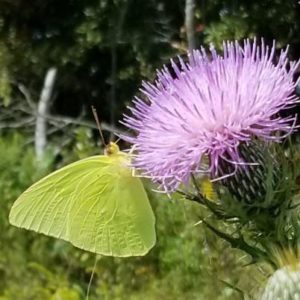
Cloudless sulphurs can be found in most of the eastern U.S. They are more common from approximately Kentucky south, but scattered individuals have been found as far north as Canada. They are also one of our migratory butterflies.
What Do They Look Like?
Adults
Cloudless sulphur butterflies are a medium sized butterfly. The wingspan is approximately 2 to 2.5 inches wide, or roughly somewhere between the length of your thumb and the diameter of a soda can.
As their name suggests, cloudless sulphur butterflies are a cheery, yellow color. The males are typically almost all yellow on the top, although they can have some relatively small spots, especially in the winter.
The females are yellow, often with a very narrow dark or reddish line highlighting the outside edges of the wings. When the wings are closed, females have one or more (often three) white spots, often edged in a reddish or dark color. The spots remind me of the spots and blemishes you often find on leaves, and there’s a good reason for that. Cloudless sulphurs often close their wings when they land, and these bright yellow butterflies can blend into leaves amazingly well when their wings are closed.
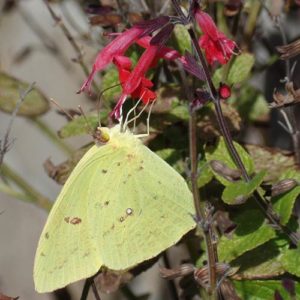
Caterpillars
The caterpillars look different depending on whether they are feeding mostly on leaves or mostly on flowers. The ones feeding mostly on leaves are green to yellowish green with a yellow line down their sides, and black dots all over. The green caterpillars may also have a neon blue splash on each segment around the yellow line. The ones feeding mostly on flowers are yellow with scattered black dots all over. They may also have a black stripe going across the back of each segment, although not all of them have that.
Pupae / Chrysalis
The chrysalis is attached to a stem and looks like a folded leaf. It can be “leaf green,” a pale yellowish-green, or a pinkish-reddish color.
Where to Find Cloudless Sulphurs
Adults
Cloudless sulphur butterflies will nectar from a wide variety of flowers that grow in open areas. That means they are commonly seen in gardens, fields, and prairies across their range.
Caterpillars
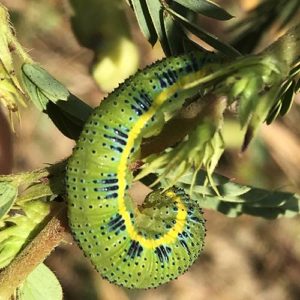
The caterpillars can most often be found on plants in the genera Senna and Cassia. Both of these genera are in the pea family and have toxic properties which they apparently concentrate and use for protection. They will also feed on species in the genus Chamaecrista, which includes partridge pea (Chamaecrista fasciculata)
Life History
Male cloudless sulphur butterflies actively look for females to mate with and will often patrol areas with lots of flowers in the hopes of finding a receptive female. After mating, the female will find an acceptable host plant and lay her eggs individually among the leaves. Ants and other predator insects have been known to eat the eggs if they find them.
Once the caterpillar emerges from the egg, it begins feeding on the host plant. The color of the caterpillar depends, in part based on whether it is primarily eating leaves or flowers. Like other species of caterpillars, it will go through several molts before attaching itself to a branch or other object and forming a chrysalis in which to pupate.
In more northern parts of its range, there is typically only one generation of cloudless sulphurs per year. In more southern parts of its range, there are usually 2-3 generations. Cloudless sulphurs can’t withstand cold temperatures at any stage of their life cycle, which is why each fall they migrate south. Many will overwinter in Florida, although they can also be found in South America.
Cloudless Sulphur Migration
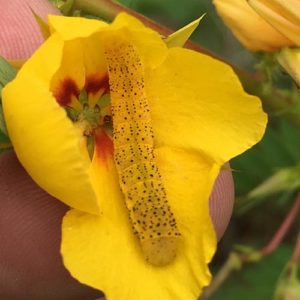
Like with monarch butterflies, the cloudless sulphur migration takes place over multiple generations each year. In the spring and summer, successive generations slowly push further north.
Unlike spring bird migrations, cloudless sulphur butterflies aren’t “trying to get to their breeding grounds.” Instead, each generation expands a little further north as those territories become hospitable which makes the spring and summer migration not very noticeable for most of us. The fall migration, however, can be very noticeable.
In the fall, cloudless sulphur butterflies begin migrating south into warmer climates. They tend to fly somewhere between 3 and 9 feet off the ground, which puts them at roughly eye level and makes them very easy to casually observe. I often watch them out the window as I work at my desk.
Fall migrating cloudless sulphur butterflies fly in a generally south to southeastern direction. Where I live, I see most of them in September and October, although some years I’ll still see an occasional cloudless sulphur on warm days in early December. How can you not smile when you see a bright yellow butterfly in December?
Attracting Cloudless Sulphur Butterflies
Having a wide diversity of summer and fall blooming flowers planted in your yard, especially if it is a “more open” yard is a good way to attract adult cloudless sulphur butterflies. Two interesting facts about cloudless sulphur butterflies is that they have a relatively long proboscis or “tongue,” and they can frequently be found nectaring on red, tubular flowers.
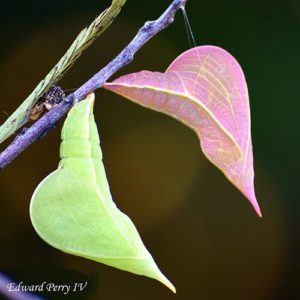
That means flowers that we typically think of as “hummingbird flowers” are also likely to be visited by cloudless sulphurs. Like hummingbirds, cloudless sulphurs will visit lots of other shapes, sizes, and colors of flowers, but we don’t always think about red, tubular flowers as also being “butterfly flowers.”
Planting host plants for the caterpillars is another great way to attract cloudless sulphurs to your yard. The mommas are going to go to where they can feed their babies. So, if you have the host plants, then you increase your odds of nearby females coming to lay their eggs on those plants. So, by including the host plants, you’ll have the opportunity to see the females, the caterpillars, and then later the new adult butterflies.
Summary
Cloudless sulphur butterflies can be frequent visitors to gardens, parks, and other open areas full of flowers. They are also one of approximately 14 different migratory butterflies in the eastern U.S. Their bright yellow coloration, tendency to fly at eye level, and preference for open, sunny areas make them easy to observe, especially during their fall migration.

Backyard Ecology: Exploring Nature in Your Backyard
Nature isn’t just “out there.” It’s all around us, including right outside our doors. Hi, my name is Shannon Trimboli, and I am the host of Backyard Ecology. I live in southcentral Kentucky and am a wildlife biologist, educator, author, beekeeper, and owner of a nursery specializing in plants for pollinators and wildlife conservation. I invite you to join me as we ignite our curiosity and natural wonder, explore our yards and communities, and improve our local pollinator and wildlife habitat. Learn more or subscribe to my email list at www.backyardecology.net.

Leave a Reply